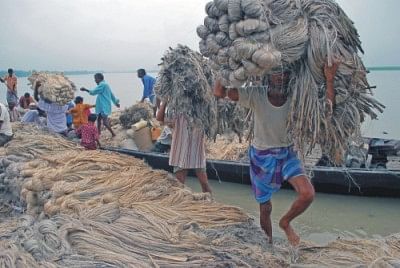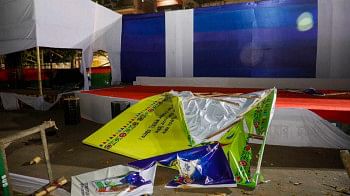A catalyst for technological development

Jute production gets a boost. Photo: Quddus Alam/ Drik News
THE announcement by the PM in parliament on June 16 that Bangladeshi scientists had unlocked the genetic code of the jute genome was a welcomed news as this discovery, if properly utilised, can give Bangladesh the competitive edge that can restore its position as the world's leading grower and exporter of jute. Jute and jute products could even become our main foreign exchange earner.
This is also inspirational news for the Bangladeshi scientific community as it demonstrates that given the right support and conditions our scientists are capable of carrying out internationally competitive research.
The sequencing of the jute genomic DNA is indeed a scientific achievement, which the most advanced laboratories in the world would be proud of. The concerned scientists deserve all the accolades that have come their way. The novel genetic information can now be used to produce new jute varieties that have higher yield and better fibre quality, that are adapted to environmental challenges such as salinity, drought and water logging, and resistant to microbial infections and parasitic infestations.
However, what has been achieved till now is only the first step in a very long process of sustained research and development. How soon this is completed will depend on what scientific expertise and research infrastructure is already available in Bangladesh or can be put in place in a short time.
The current euphoria is understandable but the celebration can perhaps wait till the necessary science and technology (S&T) infrastructure and expertise needed to complete this project, and to competently tackle other national priority projects, is established.
The story of the jute genome decoding project is inspirational and requires re-telling as a number of important observations can be made and some very useful lessons can be learnt from it. The reported success has been due to a multidisciplinary team effort that demonstrates that such positive accomplishments are possible in Bangladesh if the necessary enabling conditions are provided.
The main credit should go to the individual efforts of an exceptional group of scientists and organisations and the extraordinary faith of a courageous and resolute minister in their ability.
The principal investigator Dr. Maqsudul Alam, a NRB scientist provided visionary leadership, and it was also through him that the high-end expertise and facilities required for the sequencing became available to the jute project through his affiliations at the University of Hawaii and the University of Science, Malaysia (Penang) where he and his team had previously sequenced the genomes of papaya and rubber, respectively.
The initial suggestion about jute genome sequencing was put forward by Prof. Ahmad Shamsul Islam (Moderator, Global Network of Bangladeshi Biotechnologists, GNOBB) more than two years back, but Dr. Alam and some resident scientists were unable to find the required funding till a fortunate set of events unfolded in quick succession.
An article by Mr. Munir Hasan in Prothom Alo on how the published sequence of the rice genome was being used by researchers at Dhaka University's Department of Biochemistry and Molecular Biology to construct new rice varieties resistant to environmental stress caught the eye of Agriculture Minister Begum Motia Choudhury, and in a follow up meeting with the scientists she was informed that similar things were also possible with jute.
Begum Motia Choudhury immediately invited Dr. Maqsudul Alam to fly over from Malaysia, offered Tk.10 crore for the project and had the offer immediately affirmed by the PM. The rest is history. However, Dr. Maqsudul Alam would be the first to point out that the project would not have got off the ground had it not been for dedicated researchers and the biological resources available in Bangladesh.
Among the resident Bangladeshi scientists the major credit goes to DU biochemists Prof. Haseena Khan and Prof. Zeba Seraj who have worked in tandem over many years and under very difficult circumstances to establish a very productive crop biotechnology laboratory, which, unfortunately, is still not properly equipped.
Special thanks for the success of the jute genome project are also due to their young and enthusiastic research students whose intellectual capability and dedication are second to none. Imagine what would be possible if a proper research culture existed in our academic institutions!
The large and invaluable collection of jute variants at the Jute Research Institute has given the Bangladeshi research team a comfortable head start over other international competitors. Bio-informatics is a major tool for constructing genomic profiles from large arrays of random gene sequences and for analyses of these profiles. Bio-informatics support has been ably provided by a team of computer scientists from a local IT company DataSoft led by Mr. Mahbub Zaman.
This collaboration of public sector researchers with a private sector IT company is a very positive development and an innovative application of Digital Bangladesh that was probably not anticipated by most of its proponents.
Now that the jute genome project has the full attention of the government and policy makers, it is opportune time to highlight some important take home messages and what can be learnt from these to build a robust and enduring science and technology platform, enforced by home grown intellectual capital, that will enable Bangladesh to meet all current and future challenges and fulfil the expectations of Vision 2021.
Bangladesh has a reservoir of scientific talent, biological resources and even some expensive equipment, but these are most often widely dispersed and under-utilised due to a lack of critical mass of researchers. Bringing these together to form multidisciplinary research teams can pay high dividends, as can be seen in the case of the jute genome sequencing project. This process should be replicated to successfully tackle all national research priorities.
The capability and dedication of research students involved in this project have been amply demonstrated. The full potential of postgraduate research and its benefit to the country could be realised through the provision of well paying scholarships to the brightest students involved in research in areas of highest national priority.
The pivotal leadership of Dr. Maqsudul Alam in the success of the jute project should be a strong incentive to invite the participation of other NRB scientists, in whatever capacity or duration, in all areas of national priority. Most NRB scientists willing to help their country of origin would be happy to provide their time and advice for free if invited.
Much of the high-end technologies and equipment needed for this project became available through Dr. Alam's laboratories in Penang and Hawaii. However, if Bangladesh wishes to become internationally competitive and have unencumbered ownership of intellectual property in future, the required expertise and contemporary technologies need to be established here.
The jute genome project has led to the establishment of a dynamic bio-informatics technology group which could become the nucleus of a bio-informatics network in Bangladesh. Other advanced technologies needed to complete the jute genome project, such as functional genomics, proteomics and metabolomics, will be equally useful for other major biotechnology projects and need to be established without delay as national core facilities at selected centres of excellence.
The initial grant of Tk.10 crore from the agriculture minister got the jute genome project up and running. Her subsequent offers of higher salaries and better working conditions for the researchers were reiterated by the PM during her reception to the research team. The Parliamentary Standing Committee for Jute has recommended a further allocation of Tk.100 crore to jute research. However, other priority areas of research also need to be adequately supported through a comprehensive government policy for the funding and support of scientific research.
As the collaborating universities and various research institutions and funding sources fall under the jurisdiction of different ministries and the UGC, the government should seriously consider the formation of a national research council for proper coordination and peer-reviewed funding of major collaborative research programs in areas of highest national priority.
The procedural success of the jute genome project vindicates what has been widely advocated by the biotechnology community in Bangladesh over the years. In support of the biotechnology community efforts, I had discussed at length all the above issues of research management and research capacity development, including intellectual property development and commercialisation of research, in numerous op-ed pieces in this newspaper and articles in its monthly magazine (Forum). For review readers may wish to refer to: A. Azad, "A case for biotechnology," Forum June 2007; A. Azad, "You are what you study," Forum September 2009; A. Azad, "Moving on up," Forum May 2010.
In response to the government's National Biotechnology Policy, resident and NRB biotechnologists attending an international biotechnology conference in Dhaka in 2007 prepared a position paper and a set of recommendations to help in the implementation of the government's biotechnology policy. These were formally submitted to the government in April 2007 but to date are gathering dust in the archives of relevant ministries.
Hopefully, because of the positive publicity generated by the jute genome saga, the government may wish to reconsider the collective suggestions from the biotechnology community and engage with them in preparing a roadmap for biotechnology research.

 For all latest news, follow The Daily Star's Google News channel.
For all latest news, follow The Daily Star's Google News channel. 



Comments